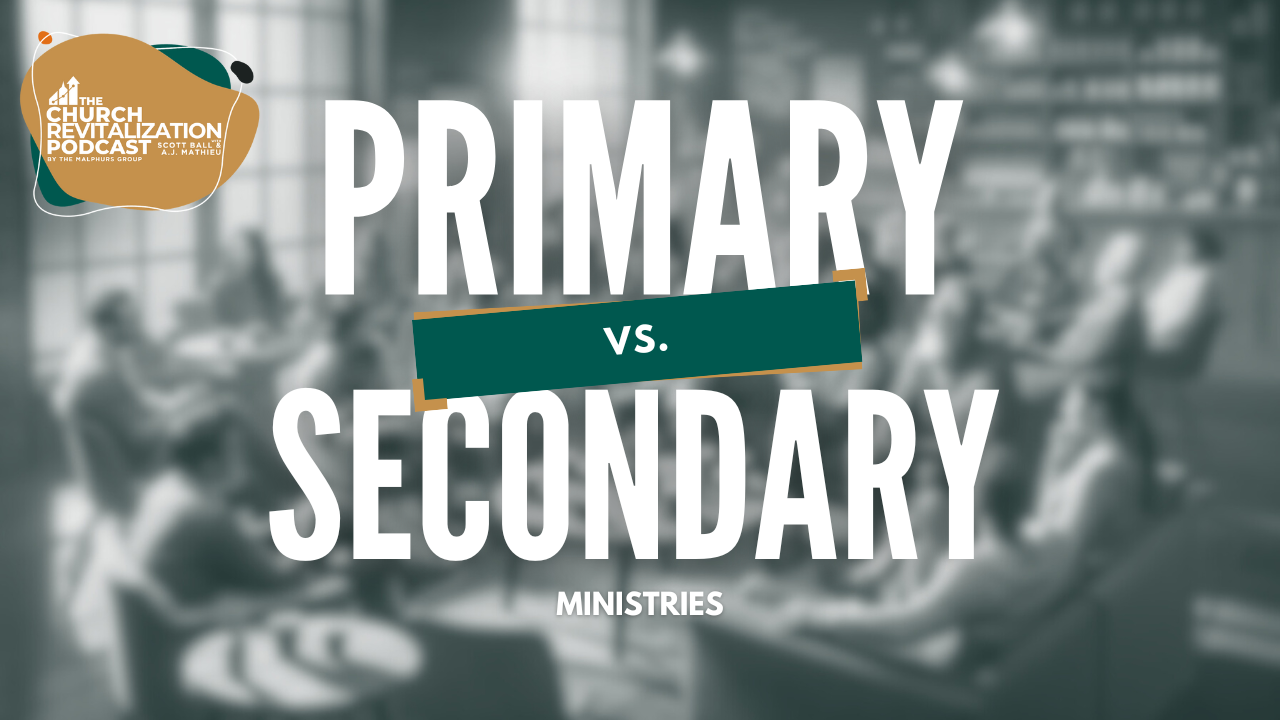Everything your church does must be aimed at making and maturing disciples. But not everything your church does is automatically discipleship-centered. This only happens when a church intentionally defines discipleship outcomes through a process or pathway and develops ministries that effectuate that process.
Put another way, every program, ministry, or event needs to have a point. Without discipleship-focused intentionality, the programs themselves become the point. The church begins to exist to sustain the programs and judges success based on attendance rather than actual spiritual growth. The programs are tertiary to the process.
That said, programs are important. To say that they are the means rather than the ends in no way invalidates the role they play. However, not all programs are created equal.
Every church has primary and secondary ministries. Primary ministries are the drivers of spiritual growth, and secondary ministries exist to support and supplement primary ministries. In this article, we will explore how to leverage primary and secondary ministries and how to avoid the biggest pitfall in implementing these ministries.
Primary Ministries
In the endeavor to cultivate a thriving discipleship pathway within the church, it is imperative that each step be anchored by a singular primary ministry. This cornerstone ministry is not merely one among many; it is the program or activity that the church leadership anticipates every member to partake in. The exclusivity of a primary ministry at each juncture of the discipleship pathway ensures clarity of purpose and direction for all members, guiding them seamlessly from one stage of spiritual growth to the next.
The efficacy of a primary ministry lies in its targeted capacity to foster specific discipleship outcomes. It is not enough for these ministries to merely exist or to engage participants in a church routine. Instead, they must be meticulously designed and executed to ensure that they achieve spiritual formation. Each primary ministry should function as a crucible within which disciples are not only informed but transformed, emerging with deeper faith, understanding, and commitment.
To achieve its intended impact, a primary ministry must resonate with and mobilize the entire church community. This universal engagement is crucial for fostering a cohesive and supportive environment where spiritual growth can flourish. A primary ministry that successfully engages the whole church becomes more than just a program; it transforms into a communal journey of faith where every member, regardless of their stage in the spiritual journey, finds a place and a purpose. This collective participation not only enriches the individual experience of discipleship but also strengthens the communal bonds within the church, making the primary ministry a pivotal element of the church’s life and mission.
Secondary Ministries
While primary ministries serve as the bedrock of the discipleship pathway, secondary ministries play a more nuanced role within the church ecosystem. It is understood that not every congregant will engage with these secondary ministries. Their participation may be constrained by various factors such as limited capacity or the specialized nature of the ministry itself, catering to a specific segment of the church population. This selective engagement is by design, allowing these ministries to address more focused needs without the expectation of universal involvement.
The purpose of secondary ministries is to provide support or enhancement to the primary ministries, acting as complementary forces rather than standalone entities. Their goal is not to overcrowd the church calendar with activities but to enrich the spiritual journey initiated by the primary ministries. By doing so, they help deepen the engagement of church members with the core discipleship process, ensuring that the primary ministries’ impact is amplified rather than diluted by additional programs.
Despite their supportive role, it is critical that secondary ministries are imbued with a clear purpose and objective. They must be carefully managed to ensure that they do not inadvertently siphon attention, resources, or focus away from the primary ministries. The balance is delicate; secondary ministries should enhance, not overshadow, the central pathways of discipleship. Their success is measured not by their attendance metrics but by their ability to clearly reinforce the foundational work of primary ministries, ensuring a holistic approach to spiritual growth and community engagement within the church.
The Pitfalls
Navigating the intricate landscape of church ministries is fraught with potential pitfalls, chief among them being the challenge of communication. The crux of the matter lies in the prioritization of ministries; when all programs are presented as of equal importance, the essence of prioritization is lost, and with it, the clarity of the church’s mission. Primary ministries, being the cornerstone of discipleship, must be accorded a disproportionate share of communication and focus. This ensures that the congregation understands their paramount importance in the spiritual ecosystem of the church, guiding members effectively through their spiritual journey.
Another critical pitfall is the failure to recognize the transient nature of ministries. Every ministry, no matter how successful at its inception, has a lifecycle. The commitment of the church should be to the process of discipleship, not to the programs that facilitate it. This distinction is vital. It allows for a dynamic approach to ministry planning, where programs are regularly evaluated for their effectiveness and relevance. When a program no longer serves its intended purpose or fails to contribute meaningfully to the discipleship pathway, it must be reevaluated and, if necessary, replaced. This ensures that the church remains responsive and adaptive, fostering an environment where spiritual growth is continually nurtured.
The phenomenon of ‘program creep’ presents a further hazard, where the accumulation of programs, each perhaps valuable in its own right, begins to detract from the focus on primary ministries. Even well-attended or popular programs must be scrutinized and potentially sunsetted if they begin to overshadow the primary objectives of discipleship. True leadership within the church context involves making tough decisions, discerning when to curtail or discontinue programs for the greater good of the church’s mission. It is about recognizing the difference between what is good and what is best for the spiritual health and growth of the congregation, ensuring that the primary focus remains on those ministries that are essential to making and maturing disciples.
—
In conclusion, the strategic delineation between primary and secondary ministries within the church is fundamental to fostering a focused and effective discipleship pathway. Primary ministries, as the main drivers of spiritual growth, must be clearly defined, universally embraced, and given precedence in communication and resources. Secondary ministries, while supportive and valuable, should enhance rather than compete with the primary ministries, serving specific needs without diluting the overarching mission of disciple-making.
The church must navigate these dynamics with careful consideration, avoiding the pitfalls of ambiguous communication, program stagnation, and the unchecked proliferation of ministries. By maintaining a clear focus on the process of discipleship and being willing to adapt or sunset programs as necessary, the church can ensure that its ministries remain vibrant and effective tools for spiritual growth.
Ultimately, the success of a church’s ministry strategy lies not in the quantity of programs it offers but in the quality and clarity of its discipleship pathway. By prioritizing primary ministries, supporting them with targeted secondary ministries, and remaining vigilant against common pitfalls, the church can create a nurturing environment where every member is encouraged and equipped to grow in their faith.
Watch this episode on YouTube!


Scott Ball is the Vice President and a Lead Guide with The Malphurs Group. He lives in East Tennessee with his wife and two children. (Email Scott).

